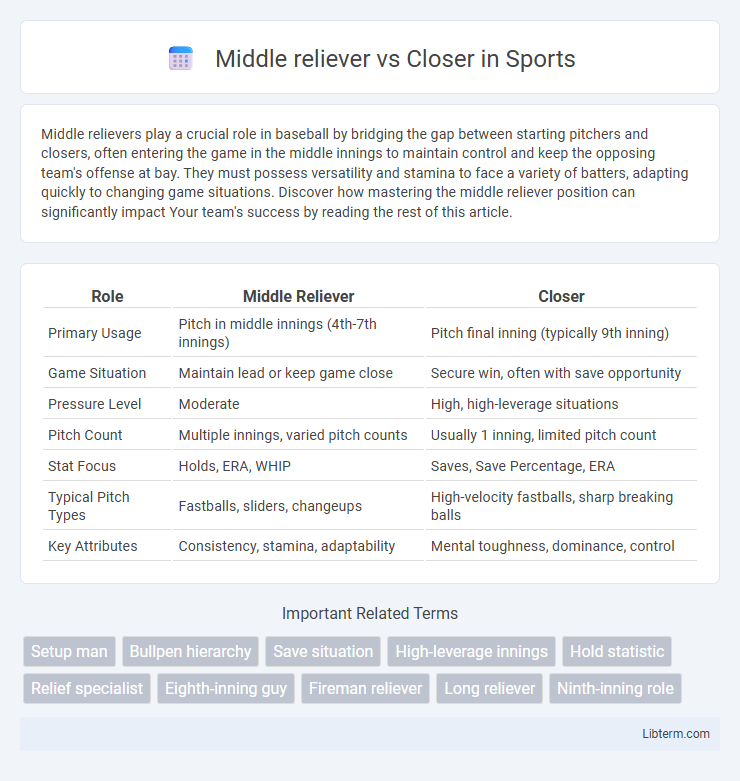Middle relievers play a crucial role in baseball by bridging the gap between starting pitchers and closers, often entering the game in the middle innings to maintain control and keep the opposing team's offense at bay. They must possess versatility and stamina to face a variety of batters, adapting quickly to changing game situations. Discover how mastering the middle reliever position can significantly impact Your team's success by reading the rest of this article.
Table of Comparison
| Role | Middle Reliever | Closer |
|---|---|---|
| Primary Usage | Pitch in middle innings (4th-7th innings) | Pitch final inning (typically 9th inning) |
| Game Situation | Maintain lead or keep game close | Secure win, often with save opportunity |
| Pressure Level | Moderate | High, high-leverage situations |
| Pitch Count | Multiple innings, varied pitch counts | Usually 1 inning, limited pitch count |
| Stat Focus | Holds, ERA, WHIP | Saves, Save Percentage, ERA |
| Typical Pitch Types | Fastballs, sliders, changeups | High-velocity fastballs, sharp breaking balls |
| Key Attributes | Consistency, stamina, adaptability | Mental toughness, dominance, control |
Introduction to Relief Pitchers: Middle Reliever vs Closer
Middle relievers primarily bridge the gap from starting pitchers to late-inning specialists, often pitching in the 6th or 7th innings to maintain game momentum. Closers are designated to pitch in high-leverage situations, typically the 9th inning, tasked with securing the final outs to preserve a lead. Both roles require distinct mental toughness and pitching strategies tailored to their inning-specific responsibilities in Major League Baseball.
Defining the Roles: What is a Middle Reliever?
A middle reliever is a relief pitcher who enters the game after the starting pitcher but before the closer, typically pitching in the middle innings to maintain the team's lead or keep the game close. Middle relievers are tasked with bridging the gap between the starter and late-inning specialists, often facing a mix of hitters to prevent offensive momentum. Unlike closers, who usually pitch in save situations during the final inning, middle relievers play a crucial role in stabilizing the game and setting up the bullpen for later innings.
The Closer: Key Responsibilities and Skills
The closer in baseball is primarily responsible for securing the final outs of a game, often entering high-pressure situations to maintain a lead. Key skills for a closer include exceptional velocity, precise control, and mental toughness to handle intense moments. Unlike middle relievers who bridge the gap between starters and closers, closers specialize in delivering consistent, dominant performances in the ninth inning.
Key Differences Between Middle Relievers and Closers
Middle relievers typically pitch in the middle innings, tasked with maintaining the game's status quo and bridging the gap between starters and closers, often facing a variety of batters in different situations. Closers, on the other hand, specialize in pitching the final inning, usually the ninth, with a high-leverage role aimed at securing the win, often relying on dominant pitches and mental toughness under pressure. The primary difference lies in their usage patterns and situational roles: middle relievers provide length and flexibility, while closers are designated finishers in save situations, impacting their statistical profiles such as ERA, WHIP, and save opportunities.
Game Scenarios: When Is Each Role Used?
Middle relievers typically enter the game during the middle innings, often when the starter struggles or to bridge the gap between the starter and late-inning relievers; they handle situations where the team has a narrow lead or is tied. Closers are deployed primarily in the ninth inning to secure a save, usually in close games with a lead of three runs or fewer. While middle relievers manage variable game scenarios and multiple innings, closers are reserved for high-pressure, final-out situations to protect the team's lead.
Essential Skills for Middle Relievers
Middle relievers require exceptional endurance to maintain effectiveness over multiple innings and must possess command over a variety of pitches to adapt to different batters. Their ability to quickly enter the game and neutralize baserunners is crucial, making control and velocity top priorities. Unlike closers who often rely on high-pressure fastballs, middle relievers emphasize versatility and the capability to induce ground balls or strikeouts in diverse game situations.
Essential Skills for Closers
Closers require exceptional composure under pressure, precise pitch control, and the ability to execute high-velocity strikes in critical game moments. Mastery in pitch sequencing and mental toughness distinguishes closers from middle relievers, enabling them to secure wins during the final innings. The ability to consistently deliver fastballs, sliders, and changeups with pinpoint accuracy is essential for effective closing performances.
The Evolution of Relief Pitching in Modern Baseball
Modern baseball has seen the evolution of relief pitching with clear distinctions between middle relievers and closers, roles shaped by strategic game management and pitch usage trends. Middle relievers often handle critical innings to bridge starters and closers, emphasizing stamina and diverse pitch arsenals, while closers specialize in high-leverage, late-inning situations requiring dominant fastballs and breaking balls. Advanced analytics have refined these roles, optimizing pitcher deployment based on matchup probabilities and workload management to maximize team success.
Impact on Team Strategy and Game Outcomes
Middle relievers play a crucial role in maintaining leads and bridging the gap between starting pitchers and closers, often facing challenging situations with runners on base. Closers specialize in securing the final outs in high-pressure scenarios, directly influencing the team's ability to win tight games. Effective utilization of both roles shapes bullpen management strategies, impacting overall game outcomes and season-long team success.
Choosing Between Middle Reliever and Closer: What Teams Consider
Teams consider workload distribution, situational performance, and pitcher stamina when choosing between a middle reliever and closer. Middle relievers are typically used to bridge early innings, managing high-leverage situations with flexibility, while closers specialize in securing the final inning, often excelling under intense pressure. Evaluating hitters faced, pitch effectiveness, and mental resilience helps teams optimize bullpen roles for maximum impact.
Middle reliever Infographic

 libterm.com
libterm.com